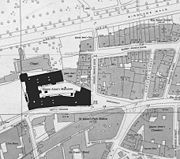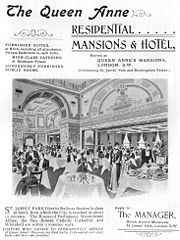
Queen Anne's Mansions
Encyclopedia

Apartment
An apartment or flat is a self-contained housing unit that occupies only part of a building...
in Petty France, Westminster
Westminster
Westminster is an area of central London, within the City of Westminster, England. It lies on the north bank of the River Thames, southwest of the City of London and southwest of Charing Cross...
, London
London
London is the capital city of :England and the :United Kingdom, the largest metropolitan area in the United Kingdom, and the largest urban zone in the European Union by most measures. Located on the River Thames, London has been a major settlement for two millennia, its history going back to its...
at .
In 1873, Henry Alers Hankey acquired a site between St. James's Park
St. James's Park
St. James's Park is a 23 hectare park in the City of Westminster, central London - the oldest of the Royal Parks of London. The park lies at the southernmost tip of the St. James's area, which was named after a leper hospital dedicated to St. James the Less.- Geographical location :St. James's...
and St. James Park Station.
Acting as his own architect, and employing his own labour, he proceeded to erect the first stage of the block. At twelve stories, later increased to fourteen, it was the loftiest residential building in Britain.
The Court Circular
Court Circular
The Court Circular is the official record that lists the engagements carried out by the Monarch of the United Kingdom and of the other Commonwealth Realms; the Royal Family; and appointments to their staff and to the court. It is issued by Buckingham Palace and printed a day in arrears at the back...
for January, 1897 describes them as "a stupendous pile which, for solidity, comfort and general convenience, sets all rivals at defiance, although twenty years have elapsed and imitations have been legion"
History
Hankey further extended the flats in 1874 and 1877 to the south and west.There were objections to the height of the flats, not least from Queen Victoria who could no longer view the
Houses of Parliament from Buckingham Palace
Buckingham Palace
Buckingham Palace, in London, is the principal residence and office of the British monarch. Located in the City of Westminster, the palace is a setting for state occasions and royal hospitality...
. But because existing legislation did not explicitly prohibit building over 100 ft the authorities could not stop Hankey. However, the London Building Act passed in 1894, and its 80-ft height limit, was a direct result of "Hankey's Mansions".

During the Second World War, the entire building was requisitioned as Government offices, and it was decided to construct a shelter. A long room in the west block, originally a theatre, had supporting piers built up from the foundation, and a stout reinforced concrete slab was laid to give head cover. This was a wise decision as two direct bomb-hits caused debris to overload the upper floors, causing a vertical gash through the entire building.
Queen Anne's Mansions was home to the Medical Department of the Royal Navy (Admiralty) during WW2.
In 1947, the Ministry of Works retained the building on a 21-year lease.
In 1973, Queen Anne's Mansions were demolished and later replaced by 50 Queen Anne's Gate
50 Queen Anne's Gate
102 Petty France is an office block on Petty France in Westminster, London, overlooking St. James's Park, which was designed by Fitzroy Robinson & Partners, with Sir Basil Spence and completed in 1976. It was well-known as the main location for the UK Home Office department between 1978 and 2004...
.
Facilities
A typical unit of accommodation was a living room, about 23 ft by 14 ft, a bedroom and a bathroom. In the corner blocks were some more commodious suites. Notwithstanding the prejudice against the building, no difficulty was found in letting the flats at high rents to tenants of the 'highest respectability'. A floor containing six rooms, without any grounds, commanded £300 per annum, and two rooms £60 per annum. The principal novelty of the building was the installation of hydraulic passenger lifts, at that time without precedent in domestic buildings in London. Fire control was also provided for by 98 hydrants, supplied from tanks storing 70,000 gallons on the roofs.Famous residents
- Edward ElgarEdward ElgarSir Edward William Elgar, 1st Baronet OM, GCVO was an English composer, many of whose works have entered the British and international classical concert repertoire. Among his best-known compositions are orchestral works including the Enigma Variations, the Pomp and Circumstance Marches, concertos...
(composer) "Elgar took a London flat in Queen Anne's Mansions so as to be able to concentrate on the concerto" - Augusta, Lady GregoryAugusta, Lady GregoryIsabella Augusta, Lady Gregory , born Isabella Augusta Persse, was an Irish dramatist and folklorist. With William Butler Yeats and Edward Martyn, she co-founded the Irish Literary Theatre and the Abbey Theatre, and wrote numerous short works for both companies. Lady Gregory produced a number of...
(Irish dramatist and folklorist) "AG had given up her rooms in Queen Anne's Mansions before leaving for Italy on 17 Mar," ... "she leased new rooms in Queen's Anne's Mansions at the beginning of 1902" - Sir Harry Johnston (British explorer) "Arrived in London toward the end of June, 1888, I established myself at Queen Anne's Mansions, in a small but comfortable flat on the sixth floor"
- Eliza Lynn LintonEliza Lynn LintonEliza Lynn Linton , was a British novelist, essayist, and journalist.-Life:The daughter of a clergyman and granddaughter of a bishop of Carlisle, she arrived in London in 1845 as the protégé of poet Walter Savage Landor. In the following year she produced her first novel, Azeth, the Egyptian;...
(British novelist, essayist, and journalist) - Dr. Frederick Quin (homeopathy was first established in Britain, by) "Quin died of bronchitis at the Garden Mansions, Queen Anne's Gate, Westminster, on 24 November 1878

